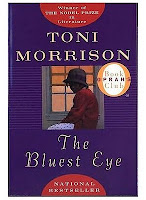182. The Bluest Eye by Toni Morrison
The Bluest Eye (Plume, 1970; 216) by Toni Morrison is one great of a read, just like all of the other Morrison's novels I've read. Like the others, this story deals with the socioeconomic and political dynamics of blacks, post-Emancipation. It also deals with identity, acceptance and placement through the lives of a given family, usually with an eccentric and idiosyncratic strong female character.
The Bluest Eye which is Morrison's first novel deals with the identity and acceptance issues. It deals with a young girl who has been praying to God to make her eyes blue and when she thought she has got it, she wondered if she had the bluest eye in the world. However, the story is more than just an eleven-year old girl's quest for 'the bluest eye of all'; it also deals with the social dynamics: the role of men in the black family, the behaviour of the larger community and their effects on families. How Pecola - the young girl in question - was raped and impregnated by her father - Cholly, how society's reaction to this misdeed led her to lose her sanity in a way, how her friends rejected her and how people described her as ugly. Her ugliness wasn't only physical. It was deemed to be more than that, for she had no one to play with.
This sort of inferiority complex, began in this book, would later permeates most of Morrison's prose. The Breedloves are a quarrelsome lot including engaging in physical fights. Both Pauline - Pecola's mother - and Cholly had their complexes. Cholly for instance was abandoned by his father when he got his mother pregnant. As a young boy, he was caught having sex with a young girl by a group of white boys who forced him to continue the act whilst they laugh. There his hatred of himself and of women will begin. This worsened when he went in search of his father who would turn the boy away in so harsh a tone and disregard for his being that the young Cholly would unknowingly defecate on himself. Pauline herself had suffered as a young girl with a shrivelled foot. She is somewhat an outcast. The story was narrated by Claudia McTeer as a child and as an adult. This first person narrative, narrated from a distance, alternates with an omniscient narrative.
Though the story concentrates on Pecola and her quest, the influential role played by Soaphead Church (or Elihue Micah Whitcomb), a man from 'aristocratic' background but who had almost descended into lunacy. Soaphead has become a trickster, a fortune teller, who grants people their quest, and a pedophile. It was he who granted Pecola's wish for blue eyes which later spiralled into insanity.
On the whole, Morrison through this novel, has questioned us why don't we like what we have or who we are? Why must we go to all lengths to change our features? For had Pecola lived today, she might have sought salvation in the colourful contact lenses and cosmetic surgery that abound. She would have had a boob-job, a butt-job, a jaw-job, a nose-job and might have spent countless sums of money, if she could afford, on skin-toning creams, human-hair weave-ons or hair-straightening creams. The question of identity has raged for a long time and there is no sign that it will be ending soon. With several Africans now spotting green and blue eyes, it is clear that there is no letting down. This was one of the themes in Zadie Smith's White Teeth, where it was stated that blacks spend - on average - more money on creams and hair products than whites. All in a bid to look like whites.
For those who haven't as yet read this book, read it. It deserves your time. In fact, anything Morrison does.
Though the story concentrates on Pecola and her quest, the influential role played by Soaphead Church (or Elihue Micah Whitcomb), a man from 'aristocratic' background but who had almost descended into lunacy. Soaphead has become a trickster, a fortune teller, who grants people their quest, and a pedophile. It was he who granted Pecola's wish for blue eyes which later spiralled into insanity.
On the whole, Morrison through this novel, has questioned us why don't we like what we have or who we are? Why must we go to all lengths to change our features? For had Pecola lived today, she might have sought salvation in the colourful contact lenses and cosmetic surgery that abound. She would have had a boob-job, a butt-job, a jaw-job, a nose-job and might have spent countless sums of money, if she could afford, on skin-toning creams, human-hair weave-ons or hair-straightening creams. The question of identity has raged for a long time and there is no sign that it will be ending soon. With several Africans now spotting green and blue eyes, it is clear that there is no letting down. This was one of the themes in Zadie Smith's White Teeth, where it was stated that blacks spend - on average - more money on creams and hair products than whites. All in a bid to look like whites.
For those who haven't as yet read this book, read it. It deserves your time. In fact, anything Morrison does.




A fine analytical review, Nana. Kudos. I have a review of this on my blog. Perhaps you could check it out. Thanks, Celestine.
ReplyDeleteHeading there
Delete